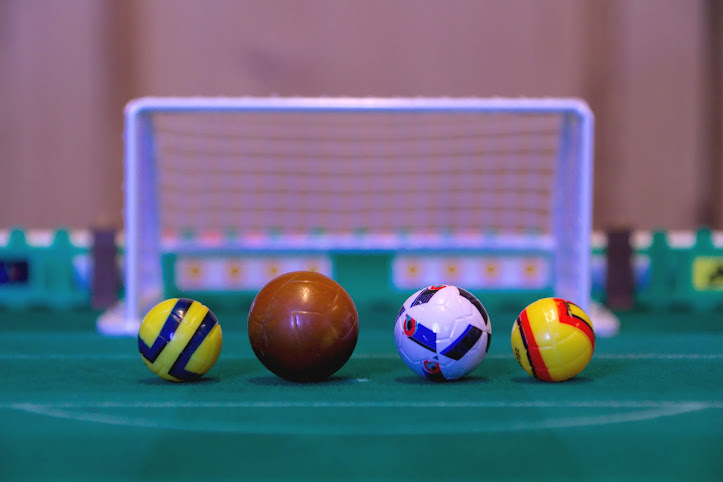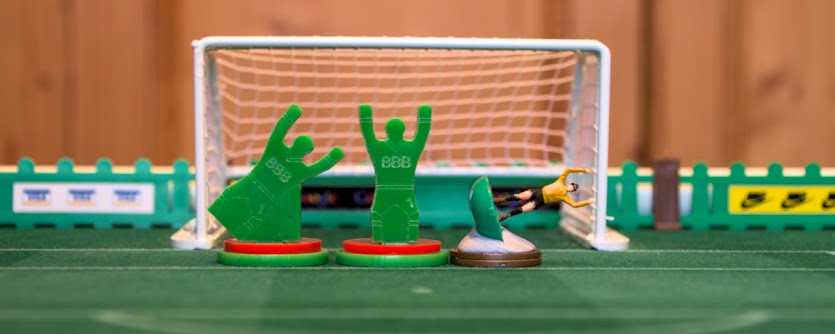Basic Equipment
To
play a decent game, one needs a few things, teams, goals, balls, and
some kind of playing surface, and to be honest from my point of view
the better the playing surface and ball, the better the game. Modern
pitch offerings are all reasonably good, apart from the nylon
versions, I own one of these and to be honest they are a far cry from
the original Subbuteo baize pitches of old. At least the originals
could be ironed, washed with care, and lay pretty flat.
Astro
or Baize
Many
years ago my grandfather made me a table on which he stuck the pitch
down, now bear in mind at that time in the early 70’s he had built
himself a ¾ size snooker table, and used a similar principle with my
Subbuteo table (minus the cushions and the pockets, or things would
have become interesting). I consider myself very lucky to have had
such luxury, I was able to play off the floor on a surface that was
flat, and to be honest it played very well. My advice to anyone who
is considering playing, is get yourself some form of table or board
to lay a pitch on a permanent basis if you possibly can. It doesn’t
have to be fancy, a decent piece of MDF or similar and some wallpaper
paste will ensure a flat stowable surface to play your matches on.
With
the vast array of pitches on offer my view would be stay away from
the nylon pitches, and go for one of the modern baize or astro
offerings, or if you can track one down an old baize pitch, of which
there are many offerings on eBay in all manner of condition, and
different price ranges. A decent baize pitch whether used or new will
serve any player well as long as one can get it to sit flat and stop
it moving. The astros are a good surface as well, they come rubber
backed so sticking them down is a must, unfortunately they can't reasonably
be ironed because of the backing, and they definitely cannot be folded or you could end up
with the Himalayas along ½ way, and as we’re already trying to
kick a set of drawers around is not going to enhance the game at all. Stick an astro down with some 3M spray glue and you have a decent
surface to play on. They are probably the most expensive option
around, so you have to decide whether it fits into your budget, also
the MDF at a reasonable 15mm thickness will probably double your
cost.
Different size balls from left to right 18mm, 25mm, 22mm, and 18mm
The
cheap option would be a baize pitch, If you are able to build a table
or board go for it, at the cheaper end build yourself a frame brace
it along it’s width and length, the screw down some hardboard onto
the frame, with the rough side facing up. I stress the rough side
facing up because lay a baize type pitch on the rough side and it
will lay nicely and will not move, if you lay it on the shiny side or
even if you use MDF some form of adhesive would be advisable to stop
any movement. If you like you can add a wooden surround to try and
stop the ball and players ending up on the floor.
I
laid my astro on a MDF board, but didn’t build any sides into the
structure, that way I could lay my baize pitch on top if ever I fancy
a change. My surround I made removable out of 25mm white conduit
which is just pushed together and can be easily lifted as a whole for
easy storage, and allows me to easily lay the baize pitch straight on
top of the astro, and then just put the surround back. The astro also
makes a terrific underlay for the cotton pitch and keeps it flat and
in position.
Whichever
pitch type I play on, I find I can still curl my heavyweights around,
but the astro does tend to allow the ball to roll faster, but you
soon get used to it.
Goals
It’s
surprising but the look and feel of the pitch can be further enhanced
by the goals you choose. When I returned to the game I used the goals
straight from the 1970 Display edition, small amounts of Blue Tack
under the posts kept the goals in place even after the hardest shots.
I then purchased a pair of Pegasus Euro goals, nice looking goals
with a base that has fixing holes so easily attached to the pitch,
only problem I found with them was their lack of depth, most shots
that hit the back of the net didn’t stay there the ball ended up
somewhere in the penalty area, causing a little confusion at times.
Apart from that you can't find fault with them. They fit together well
and a little glue around the net attachments and you're good to go. There
are many plastic goals on the new and second hand market, it’s just
a case of find a design that works for you and attach them to your
pitch by your preferred method.
At
the moment I have metal goals, which were a birthday present they are
heavy enough to stay in place without fixing, but they have mounting
holes if you need to make them a permanent fixture. I just love the
sound when the post or bar is struck, and when the ball hits the back
it tends to stay there. There is a back bar on my particular set for the rod of the goalkeeper to pass under and the gap is
generous enough to allow any keeper to be used and have full
movement. If I have a complaint it would be this back bar is great if
you play with a 22mm ball, but it does allow a smaller 18mm ball to
pass through. Again the metal goals can be found at various accessory
outlets such as Astrobase or Subbuteoworld to name but two, and there
are some nice designs in the metal offerings, as there are in their
plastic brothers.
Lets
talk balls
I
remember my first Subbuteo a
1969 Club Edition and the supplied balls seemed, and to be fair
probably were
huge compared to my 00 scale players, at
25mm (or thereabouts) and
lighter than the modern balls. There main downfall was the two
halves were glued together and in some cases with very little care,
making their straight line rolling ability a little erratic. One
could purchase smaller which were approx 18mm, I did play with these
occasionally (but never owned at the time), at the club I was a
member of, but all the league and competition matches I participated
in used their larger brethren.
The
first smaller ball I purchased back then was a Continental ball, now
this little beauty (and I say that tongue in cheek), was bigger than the "FF" 18mm, but smaller than the
"F" 25mm and came in at around 20mm, and is comparable to the modern
22mm balls of today. The only problem was the little
black stickers that decorated its exterior, they didn’t enhance it’s
rolling ability, and it was greatly improved by removing them, not
perfect but a definite improvement.
So
much for the brief history lesson. Most if not all modern balls are
fit for purpose nowadays but I still think are a tad big but saying
that that they compliment
the size of the goals well, when you start to go down in ball size I
think a reduction in goal size is also required to compensate. Buying
new in the modern era means a 22mm, but you can still purchase 18mm
if you want, I purchased a pack of Zeugo 18mm to give them a try,
they performed better on a baize pitch compared to the astro, but
with my standard goals my match scores increased, and I haven’t a
set of smaller goals at the moment to try. In my opinion if you’re
playing solo go with the ball size that suits you best to get the
most out of your games and player types you use.
In
summary
I
can only give you my impressions and opinions of the available
equipment that I have tried and owned. Its up to you to make the
final decision and draw your own conclusions and budget. Myself I enjoy playing
on an astro, with metal goals heavyweights, and 22mm balls, a
friend of mine David is playing at this moment in time, on a baize
pitch, with lightweights, smaller goals and an 18mm ball. We both
play different but not dissimilar rules, and both enjoy our hobby. In
your solo universe if it looks and feels right who is going to argue.
Keep
On Flicking.
Ian




Comments
Post a Comment